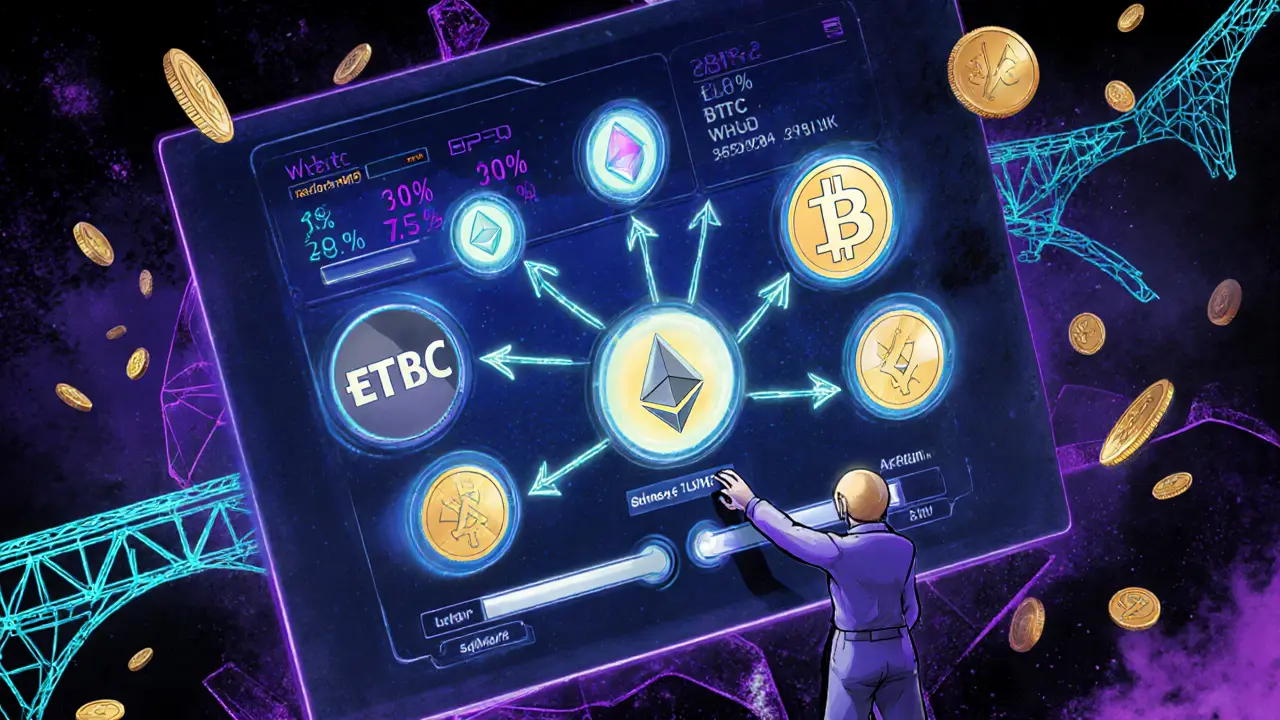- Home
- Cryptocurrency
- Balancer v2 (Arbitrum) Crypto Exchange Review: Low Fees, Complex Pools, and Niche DeFi Use Cases

Balancer v2 (Arbitrum) Crypto Exchange Review: Low Fees, Complex Pools, and Niche DeFi Use Cases
Balancer v2 Impermanent Loss Calculator
Impermanent Loss Result
What Is Balancer v2 on Arbitrum?
Balancer v2 on Arbitrum isn’t a traditional crypto exchange like Binance or Coinbase. It’s a decentralized exchange (DEX) built on Arbitrum, a Layer 2 network that makes Ethereum transactions faster and cheaper. Launched in 2021, it’s an upgrade of the original Balancer protocol, designed to solve Ethereum’s high gas fees while keeping its core innovation: multi-token liquidity pools with customizable weights.
Unlike Uniswap, which mostly trades pairs like ETH/USDC at a 50/50 ratio, Balancer lets you create pools with up to eight different tokens. You can set weights like 40% ETH, 30% WBTC, 20% LINK, and 10% USDC. These pools don’t just let you trade-they automatically rebalance as prices change, acting like a self-managing portfolio. That’s why many users call it a DeFi portfolio manager disguised as a DEX.
How It Works: Pools, Fees, and Smart Routing
At the heart of Balancer v2 are three types of pools:
- Weighted Pools: The default. You pick tokens and assign weights. If ETH rises, the pool sells some ETH and buys the others to restore balance.
- Stable Pools: Optimized for tokens with similar values, like USDC, DAI, and USDT. Less slippage, lower impermanent loss.
- Boosted Pools: These integrate with other DeFi protocols like Curve or Aave to earn extra yield on top of trading fees.
When you trade, Balancer doesn’t just use one pool. Its smart order routing scans all available pools on Arbitrum to find the best price. If you’re swapping WBTC for LINK, it might split your trade across three pools to minimize slippage.
As a liquidity provider, you earn a share of trading fees-no need to stake or lock tokens long-term. But you’re still exposed to impermanent loss, especially if one token in your pool spikes or crashes. Balancer offers a built-in impermanent loss calculator to help you estimate risk before depositing.
Why Choose Balancer v2 on Arbitrum?
The biggest advantage is cost. On Ethereum mainnet, swapping tokens can cost $5-$15 during peak times. On Balancer v2 on Arbitrum, the average gas fee is around $0.05. That’s a 97% drop, according to QuickNode’s 2025 data.
It’s also the only DEX on Arbitrum that lets you create custom multi-token portfolios. If you’re holding a mix of DeFi tokens and want them to automatically rebalance without manually trading, this is one of the few tools that does it natively.
For liquidity providers who manage large or diversified portfolios, Balancer’s Protocol Vault feature reduces the number of transactions needed to rebalance, cutting gas even further. And with the recent launch of Managed Pools and Tranche Vaults, professional asset managers and DAOs can now control pool weights dynamically-something Uniswap v3 still can’t do.

Where It Falls Short
But Balancer v2 on Arbitrum isn’t for everyone. Its 24-hour trading volume hovers around $312,000, compared to Uniswap v3’s $240 million on the same network. That means:
- Slippage is high on larger trades. A $10,000 swap might move the price by 5% or more.
- Liquidity is thin for lesser-known tokens. You won’t find 80% of the coins listed on centralized exchanges.
- The interface is complex. Adding liquidity to a 3-token pool takes 3-5 hours of learning for beginners, according to user surveys.
Many users on Reddit and Trustpilot complain about the learning curve. One user said it took them three hours just to set up a pool-something they could do in three minutes on Uniswap. There’s no customer support, no live chat, and no phone number. If you get stuck, you’re on your own in Discord or the forums.
Security is another concern. Balancer was hacked in 2020 for $500,000. While v2 has been audited and improved, its complex smart contracts still carry higher risk than simpler AMMs. Stanford’s DeFi research team warned in early 2025 that many liquidity providers don’t fully understand how multi-token pools increase exposure to correlated asset risks.
Who Is This For?
Balancer v2 on Arbitrum is built for a specific type of user:
- Experienced DeFi users who’ve been trading for over 18 months.
- Liquidity providers managing diversified portfolios of 5+ tokens.
- Arbitrum natives who want to avoid Ethereum’s gas fees.
- Portfolio builders who want automatic rebalancing without using a centralized service.
It’s not for:
- Beginners looking for a simple swap.
- Traders doing high-frequency or large-volume trades.
- Anyone who needs customer support or a polished UI.
A CryptoSlate survey found that 63% of Balancer v2 users use it primarily for liquidity provision-not trading. And 41% said their main goal was portfolio diversification. That tells you who this tool was made for.
How to Get Started
Here’s the step-by-step to use Balancer v2 on Arbitrum:
- Install a wallet like MetaMask or Coinbase Wallet.
- Add the Arbitrum network (you’ll need the RPC URL-QuickNode’s guide has it).
- Buy some ETH or USDC on a centralized exchange and send it to your wallet on Arbitrum.
- Go to app.balancer.fi and connect your wallet.
- Choose "Swap" to trade, or "Pool" to add liquidity.
- For pools, select your tokens and weights. Use the impermanent loss calculator before confirming.
It takes 8-12 minutes to set up the network if you’re new. But mastering pool creation? That’s a full afternoon of reading docs and watching tutorials. The documentation is technically accurate but assumes you already know what an AMM is.

Compared to Uniswap v3 and Trader Joe
Here’s how Balancer v2 stacks up against its top rivals on Arbitrum:
| Feature | Balancer v2 | Uniswap v3 | Trader Joe |
|---|---|---|---|
| Max tokens per pool | 8 | 2 | 2 |
| Custom weightings | Yes (0.01%-99.99%) | No (concentrated liquidity only) | No |
| 24-hr volume | $312K | $240M | $36M |
| Avg gas fee | $0.05 | $0.07 | $0.06 |
| Best for | Portfolio management, LPs | High-volume trading, low slippage | Simple swaps, yield farming |
Uniswap v3 dominates volume and has tighter liquidity for major pairs. Trader Joe is easier to use and offers more yield farming options. But only Balancer gives you true multi-token portfolio control.
Future Outlook
Balancer Labs is pushing hard into institutional use. In early 2025, they launched Liquidity-as-a-Service (LaaS), letting protocols pay to bootstrap liquidity using veBAL incentives. Twelve projects on Arbitrum are already using it.
They’ve also started integrating real-world assets (RWAs) like tokenized real estate and corporate debt from Centrifuge and Maple Finance. This could attract traditional finance money into DeFi.
The next big update is the Arbitrum Nitro upgrade in Q3 2025. Balancer expects gas fees to drop another 15-20% and transaction speed to increase by 30%. That could help it gain traction.
But competition is rising. Uniswap v4, coming later this year, may introduce multi-token pools. If it does, Balancer’s biggest differentiator disappears.
Final Verdict
Balancer v2 on Arbitrum isn’t the biggest or easiest DEX. But it’s the only one that turns liquidity provision into active portfolio management. If you’re holding a basket of DeFi tokens and want them to auto-rebalance while earning fees, this is one of the few tools that does it well.
For everyone else-traders, beginners, or those looking for high volume-it’s overkill. Stick with Uniswap or Trader Joe.
The real question isn’t whether Balancer works. It’s whether you need its complexity. For the right user, it’s powerful. For most, it’s a learning curve not worth climbing.
Is Balancer v2 on Arbitrum safe to use?
Balancer v2 has been audited and improved since its 2020 hack, but its complex smart contracts still carry higher risk than simpler DEXs. It’s safer than many DeFi protocols, but not risk-free. Always use a small amount of funds to test first, and never deposit more than you’re willing to lose. The platform has no insurance or customer support, so you’re fully responsible for your assets.
Can I earn yield on Balancer v2 without trading?
Yes. By providing liquidity to a pool, you earn a share of trading fees from every swap that happens in that pool. You can also join boosted pools that integrate with other protocols like Aave or Curve to earn additional yields. This is the main way most users interact with Balancer v2-not by trading, but by being a liquidity provider.
How does Balancer compare to Uniswap on Arbitrum?
Uniswap v3 has far higher trading volume, tighter spreads, and a simpler interface. It’s better for fast, high-volume swaps. Balancer v2 has lower volume but lets you create pools with up to eight tokens and customize their weights. If you want to manage a diversified portfolio automatically, Balancer wins. If you just want to swap ETH for USDC, Uniswap is faster and cheaper in practice.
Do I need to hold BAL tokens to use Balancer v2?
No. You can swap tokens or add liquidity without holding BAL. But BAL is the governance token. Holding and locking BAL as veBAL gives you voting power on protocol upgrades and boosts your fee earnings in some pools. Most users don’t need BAL to use the platform, but active liquidity providers often hold it for extra rewards.
What’s the minimum amount to start using Balancer v2?
There’s no minimum to swap tokens-you can trade as little as $1. But to add liquidity, you need enough to fill a pool meaningfully. Most users start with $500-$1,000. Smaller deposits may get diluted by larger LPs and earn minimal fees. For multi-token pools, you’ll need at least $1,000 to make the complexity worth it.
Can I use Balancer v2 on mobile?
Yes, but not through a native app. You can use it through MetaMask or Coinbase Wallet on your phone. The website works on mobile browsers, but the interface isn’t optimized for small screens. Pool creation and management are much easier on desktop. For casual swaps, mobile is fine. For serious LPing, use a computer.
Cormac Riverton
I'm a blockchain analyst and private investor specializing in cryptocurrencies and equity markets. I research tokenomics, on-chain data, and market microstructure, and advise startups on exchange listings. I also write practical explainers and strategy notes for retail traders and fund teams. My work blends quantitative analysis with clear storytelling to make complex systems understandable.
About
DEX Maniac is your hub for blockchain knowledge, cryptocurrencies, and global markets. Explore guides on crypto coins, DeFi, and decentralized exchanges with clear, actionable insights. Compare crypto exchanges, track airdrop opportunities, and follow timely market analysis across crypto and stocks. Stay informed with curated news, tools, and insights for smarter decisions.






